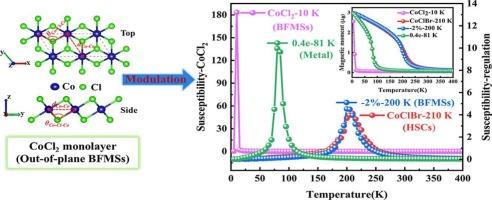CoCl2单层中的可控铁磁性:本征双极铁磁性半导体
IF 3
3区 材料科学
Q3 MATERIALS SCIENCE, MULTIDISCIPLINARY
引用次数: 0
摘要
固有双极铁磁半导体(BFMSs)单层材料具有独特的自旋和电荷特性,已成为探索下一代高速、低功耗和非易失性存储器件的理想选择。利用第一性原理计算,我们预测了CoCl2单层是一种稳定的面外bfms,具有较大的间接自旋带隙(2.653 eV),其垂直磁晶各向异性能量(PMAE/0.333 meV / cell)主要来自于不同自旋通道中穿过Lx的Co-dyz/dz2轨道和相同自旋通道中穿过Lz的Co-dxz/dyz轨道的耦合。在打破镜面对称后,其Janus单层CoClBr表现出更强的铁磁性,更高的居里温度(Tc/210 K)和新的半半导体(hsc)性质。此外,在压缩应变作用下,CoCl2单层膜的Tc和PMAE均有显著提高。例如,在−2%和−6%菌株下,Tc和PMAE分别达到200 K和0.436 meV的最大值。此外,在电子掺杂的作用下,其Tc也可以得到提高,并且会发生从BFMS到半金属再到金属的过渡。这些发现表明我们的工作为自旋电子学器件提供了一种候选材料。本文章由计算机程序翻译,如有差异,请以英文原文为准。

Controllable ferromagnetism in CoCl2 monolayer: Intrinsic bipolar ferromagnetic semiconductor
Intrinsic bipolar ferromagnetic semiconductor (BFMSs) monolayer materials with the unique spin and charge properties have become an ideal choice for exploring the next generation of high-speed, low-power and non-volatile memory devices. In this work, using first-principles calculations, we predicted that the CoCl2 monolayer is a stable out-of-plane BFMSs with a large indirect spin band gap (2.653 eV) and its perpendicular magnetocrystalline anisotropic energy (PMAE/0.333 meV per unit cell) are mainly originate from the couplings of Co-dyz/dz2 orbitals thorough Lx in the different spin channels and the Co-dxz/dyz orbitals thorough Lz in the same spin channels. And after breaking the mirror symmetry, its Janus monolayer CoClBr shows a stronger ferromagnetism, a higher Curie temperature (Tc/210 K) and a novel half-semiconductor (HSCs) property. In addition, the CoCl2 monolayer’s Tc and PMAE can be markedly improved under the compressive strain. For example, at −2% and −6% strains, Tc and PMAE can reach maximum values of 200 K and 0.436 meV, respectively. Besides, under the electronic doping, its Tc can also be enhanced and there will be a transition from BFMS to half-metal and then to metal. These findings indicate that our work offers a candidate material for spintronics devices.
求助全文
通过发布文献求助,成功后即可免费获取论文全文。
去求助
来源期刊

Journal of Magnetism and Magnetic Materials
物理-材料科学:综合
CiteScore
5.30
自引率
11.10%
发文量
1149
审稿时长
59 days
期刊介绍:
The Journal of Magnetism and Magnetic Materials provides an important forum for the disclosure and discussion of original contributions covering the whole spectrum of topics, from basic magnetism to the technology and applications of magnetic materials. The journal encourages greater interaction between the basic and applied sub-disciplines of magnetism with comprehensive review articles, in addition to full-length contributions. In addition, other categories of contributions are welcome, including Critical Focused issues, Current Perspectives and Outreach to the General Public.
Main Categories:
Full-length articles:
Technically original research documents that report results of value to the communities that comprise the journal audience. The link between chemical, structural and microstructural properties on the one hand and magnetic properties on the other hand are encouraged.
In addition to general topics covering all areas of magnetism and magnetic materials, the full-length articles also include three sub-sections, focusing on Nanomagnetism, Spintronics and Applications.
The sub-section on Nanomagnetism contains articles on magnetic nanoparticles, nanowires, thin films, 2D materials and other nanoscale magnetic materials and their applications.
The sub-section on Spintronics contains articles on magnetoresistance, magnetoimpedance, magneto-optical phenomena, Micro-Electro-Mechanical Systems (MEMS), and other topics related to spin current control and magneto-transport phenomena. The sub-section on Applications display papers that focus on applications of magnetic materials. The applications need to show a connection to magnetism.
Review articles:
Review articles organize, clarify, and summarize existing major works in the areas covered by the Journal and provide comprehensive citations to the full spectrum of relevant literature.
 求助内容:
求助内容: 应助结果提醒方式:
应助结果提醒方式:


